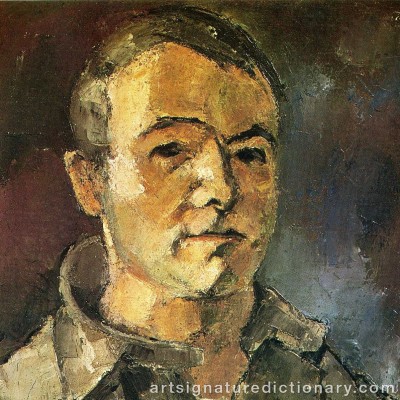
Max WEBER
1881–1961, Russia/USA
Biography
Discover the life and artistic journey of Max WEBER (born 1881, Russia, died 1961, USA), including key biographical details that provide essential context for signature authentication and artwork verification. Understanding an artist's background, artistic periods, and career timeline is crucial for distinguishing authentic signatures from forgeries.
Max Weber biography:
Born in Bialystok, Russia, on April 18, 1881, Max Weber immigrated to the United States with his mother and brother in 1891 to join his father in Brooklyn. At sixteen, Weber enrolled at the Pratt Institute, where he studied with Arthur Wesley Dow, a proponent of the Arts and Crafts aesthetic. Dow’s theories of art and design and his interest in Far Eastern painting were important influences on Weber’s artistic development. The young artist continued studying with Dow for a year following graduation until Dow moved to Virginia and, later, Minnesota to assume teaching positions.
In 1905 Weber entered the atelier of Jean-Paul Laurens at the Académie Julian in Paris but quickly found the emphasis on classical form and drawing from plaster casts rather than live models too constricting. He left in 1906, having made the acquaintance of other progressive artists, notably Abraham Walkowitz, who would become a good friend, Dunnoyer de Segonzac, and Hans Purrman. Weber briefly attended the Académie Colarossi, but his discovery of Cézanne at the Salon d’Automne in 1906 marked a turning point in his development. In response, his paintings began to display larger, paint-laden brushstrokes and more abstract forms.
Weber exhibited works in the 1906 and 1907 Salon des Indépendants and the Salon d’Automne. He shared a passion for Persian miniatures with Matisse and entered the master’s class in 1908. Weber drew nude figures from the models in Matisse’s studio and experimented with freer, Fauve-inspired color and sketchier forms.
Lack of funds forced Weber to return to the United States in 1909. He made the rounds of several galleries before his friend Edward Steichen introduced him to Alfred Stieglitz, one of America’s earliest and most influential advocates for the modernist movement. Weber shared his firsthand knowledge of European modernism. Stieglitz, in turn, supported the young painter financially. Broad brushstrokes, heavy, broken outlines, and flattened spaces characterize Weber’s work of this period.
Weber participated in the 1910 “Younger American Painters” show and several one-man shows at 291, Stieglitz’s New York gallery. At the time, critics and the public failed to appreciate Weber’s forward-thinking formal distortions. Today, Weber’s ability to marry the lessons of European modernism and American urban subject matter is viewed as his most significant contribution to twentieth-century art.
Weber adhered to a Cubist-Futurist style until roughly 1919. Following World War I, spiritual and religious themes and a more expressionistic style emerge in Weber’s work. Later, in the 1930s and beyond, Weber created many lyrical portrayals of people who shared his Eastern European origins. He used the figure to experiment with line, color, and space.
Numerous shows after 1912 in both Europe and America eventually secured Weber public recognition and financial success. Weber had a one-man show at the Newark Museum in 1919, becoming the first American avant-garde artist to be exhibited at a museum. The Museum of Modern Art in New York held a mid-career retrospective in 1930. Weber is represented in many public collections, including the Baltimore Museum of Art, Maryland; the Brooklyn Museum, New York; the Museum of Modern Art, New York; the New Jersey State Museum, Trenton; and the Whitney Museum of American Art, New York.
Source: http://www.hollistaggart.com
Explore other artists
Discover other notable artists who were contemporaries of Max WEBER. These artists worked during the same period, offering valuable insights into artistic movements, signature styles, and authentication practices. Exploring related artists makes it easier to recognize common characteristics and artistic conventions of their era.